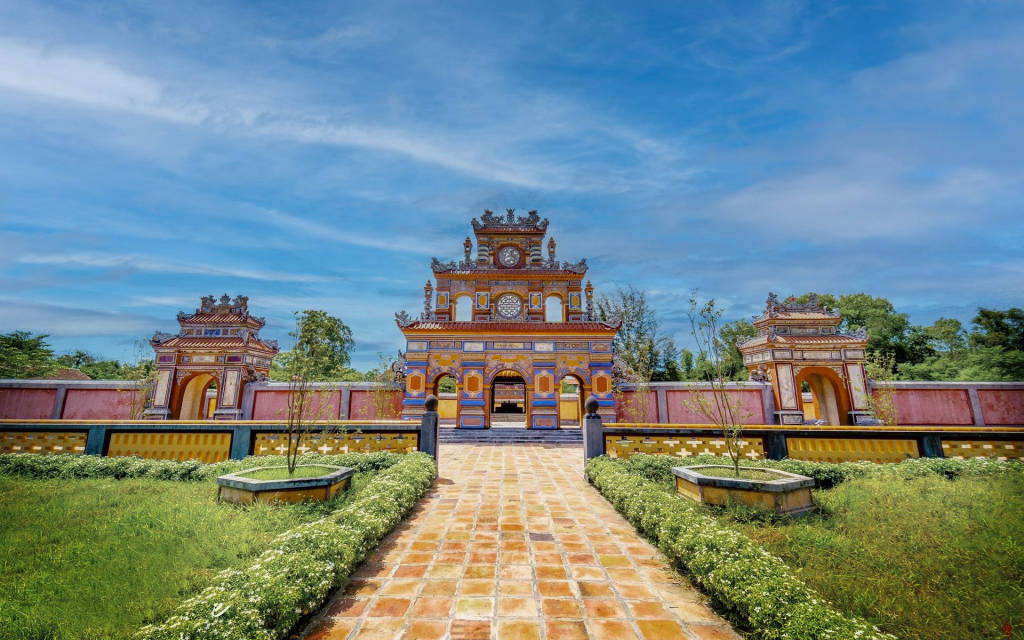Duc Duc Tomb, known as An Lang (安陵), is a monument within the Hue Imperial City complex, where Emperor Duc Duc is buried. The tomb is located in An Cuu ward, less than 2 km from Hue city center. It's an ideal destination for travelers who enjoy exploring freely and discovering the history and culture of the Nguyen Dynasty.
Duc Duc Tomb (also known as An Lang) in Hue is a special historical site, the resting place of three Nguyen Dynasty kings: Duc Duc, Thanh Thai, and Duy Tan. These kings represent three generations of patriots, willing to sacrifice for freedom and national independence. Unlike other Nguyen Dynasty tombs, Duc Duc Tomb features simple and modest architecture. It is located in An Cuu Ward, Hue City, just under 2 km from the city center, within a nearly 6-hectare area.
Architecture and Layout
The An Lang area is divided into two parts: the tomb area and the worship area. Both face northwest, with Phuoc Qua Hill as the front screen and Tam Thai Mountain behind as the rear screen, with the water stream in front symbolizing "bright hall". The rectangular tomb area covers 3,445 m² and lacks elaborate structures like stone statues or Bi Dinh. Instead, the center of the tomb is the Huynh Oc house, a simple square structure used for worship.
Long An Temple – the main building of the worship area, is built in the style of Hue royal architecture and currently houses the ancestral tablets of Kings Duc Duc, Thanh Thai, and Duy Tan. This sacred space is dedicated to remembering the contributions of these kings.
Construction History
Emperor Duc Duc, born Nguyen Phuc Ung Ai, had a brief reign of only three days before being deposed and dying in Thua Thien prison in 1883. After ascending the throne, Emperor Thanh Thai – Duc Duc's son – rebuilt his father's tomb and named it An Lang. From 1899, he constructed Long An Temple to worship his father, along with auxiliary structures like the left and right halls, where concubines resided to care for the offerings.
In 1987, the remains of Emperor Duy Tan, Duc Duc's grandson, were brought back from Africa and reburied in this area. Duc Duc Tomb is also the resting place of many royal family members, including 39 tombs of princes and princesses and 121 tombs belonging to the Nguyen Phuc family.
Historical and Cultural Value
Duc Duc Tomb is not just the resting place of kings but also a symbol of patriotism and the spirit of sacrifice for freedom by Kings Thanh Thai and Duy Tan. These kings were not afraid to give up their thrones to pursue the noble goal of national independence. The simple and unassuming tombs reflect their humility and steadfastness.
On September 27, 1997, Duc Duc Tomb was recognized as a national monument of architectural art. It is an unmissable destination for visitors who want to explore Nguyen Dynasty culture and history and learn more about the kings who devoted their lives to national independence. History enthusiasts will undoubtedly find this place fascinating, offering both an enjoyable travel experience and a rich historical exploration.
 Register
RegisterSign in Travel Agent
Sign in Supplier
Sign in Affiliate
Sign in Guru



 FH2V+F5G, Phường Phước Vĩnh, Thành Phố Huế, Tỉnh Thừa Thiên Huế, An Cựu, Huế, Thừa Thiên Huế
FH2V+F5G, Phường Phước Vĩnh, Thành Phố Huế, Tỉnh Thừa Thiên Huế, An Cựu, Huế, Thừa Thiên Huế